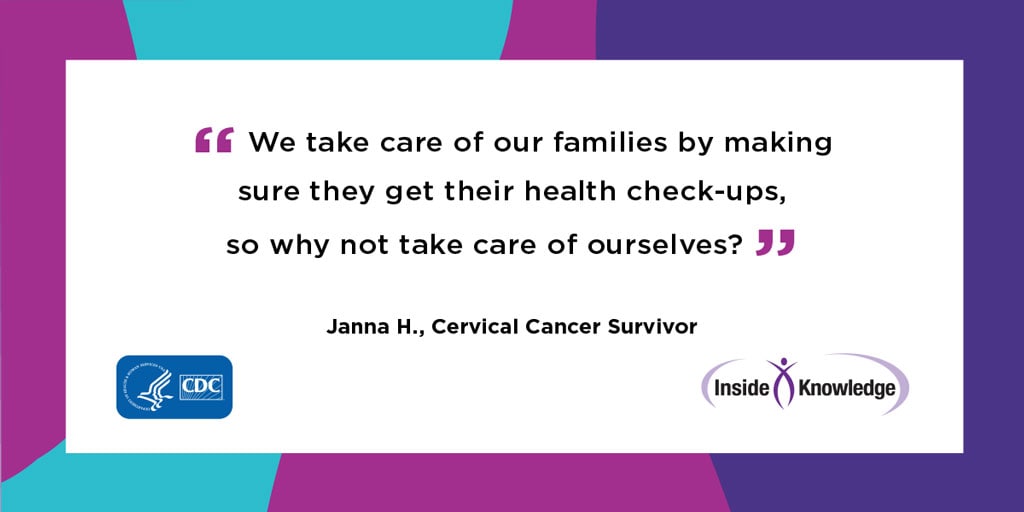And just like that, we are back in January and it's time to bring into light Cervical Cancer Awareness Month.
"Each year in the United States, about 13,000 new cases of cervical cancer are diagnosed and about 4,000 women die of this cancer. Hispanic women have the highest rates of developing cervical cancer, and Black women have the highest rates of dying from cervical cancer (Division of Cancer Prevention and Control, Centers of Disease Control and Prevention.)
Just reading this statistic makes me upset all together and raise many questions of course, but I want to focus in sharing the Inside Knowledge about Gynecologic Cancer Campaign with you ladies because I want to make sure you know about the five main types of gynecologic cancer: cervical, ovarian, uterine, vaginal, and vulvar.
We have all heard the word "Cancer", but are you conciously aware about gynecological cancer? When I ask this question in general to women, a majority of them don't know about symptoms or the different types of cancer that can exist in our wombs. We need to change this narrative, so let me start by sharing some educational information, resources, and videos.
Gynecological cancer is any cancer that starts in woman's reproductive organs. While gynecologic cancer are often discussed as a group, each is unique and has different signs, symptoms, risk factors, and prevention strategies. Cancer is always named for the part of the body where it starts, even if it spreads to other body parts later.
Cervical Cancer is located in the Cervix. Sign and Symptoms: early on cervical cancer, may not have signs or symptoms. advance cervical cancer may cause bleeding or discharge from the vagina that is not normal for you. Remember there could be other underlying issues that may not be related to cancer, so it's recommended to see your doctor.
Ovarian Cancer: is located in the Ovaries or in related areas of the fallopian tubes and the peritoneum. Signs and Symptoms: vaginal bleeding or discharge that is not normal for you. Pain or pressure in the pelvic area. Abdominal or back pain. Bloating. Feeling full to quickly or difficulty eating. A change in your bathroom habits. Remember there could be other underlying issues that may not be related to cancer, so it's recommended to see your doctor.
Uterine Cancer: the most common type of uterine cancer is also called endometrial cancer because it forms in the lining of your uterus, called the endometrium. Signs and Symptoms: may cause vaginal discharge or bleeding that is not normal for you. Bleeding may be abnormal because of how heavy it is or when it happens, such as after you have gone through menopause and between periods. Bleeding is never normal after your periods stop. Uterine cancer may also cause other symptoms, such as pain or pressure in your pelvis. Remember there could be other underlying issues that may not be related to cancer, so it's recommended to see your doctor (cdc, gynecologic cancer).
Vaginal and Vulvar Cancer: when cancer starts in the vagina, it is called vaginal cancer. The vagina, also called birth canal, is the hollow, tube-like channel between the bottom of the uterus and the outside of the body. When cancer forms in the vulva, it is vulvar cancer. The vulva is the outer part of the female genital organs. It has two folds of skin called the labia. Vulvar cancer most often occurs on the inner edges of the labia. Vaginal Cancer Signs and Symptoms: may cause vaginal discharge or bleeding that is not normal for you. Bleeding may be abnormal because of how heavy it is or when it happens, such as after you have gone through menopause and between periods. Change in bathroom habits. Pain in your pelvic the area below your stomachh and in between your hip bones, especially when you pass urine or have sex. Vulvar Cancer Signs and Symptoms: Itching, burning, bleeding on the vulva that does not go away, changes in the colore of the skin of the vulva, so that it look redder or whiter than is normal for you, skin changes in the vulva, including what looks like a rash or warts, Sore, lumps, or ulcers on the vulva that do not go away. Pain in your pelvis, especially when you urinate or have sex. Remember there could be other underlying issues that may not be related to cancer, so it's recommended to see your doctor.
Wow! that is a lot of information right and I am just sharing a minor portion. Okay, let's take a break and watch an educational video.
The Inside Knowledge Campaign came more into light with Johanna's Law who died of ovarian cancer in 2000. Her story made an impact on women's health initiatives, so it was important for me to start the new year with sharing a little information about the five types of gynecological cancer because as women we are often busy taking care of everyone else that we often dismiss symptoms. So it's time to change that narrative and follow up with medical and/or holistic providers to get screen, ask questions, and have a plan of care.




No comments